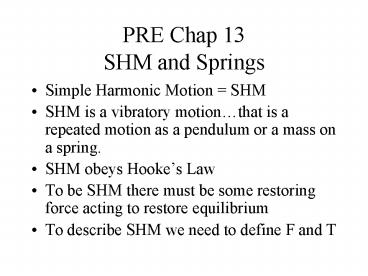PRE Chap 13 SHM and Springs - PowerPoint PPT Presentation
1 / 15
Title:
PRE Chap 13 SHM and Springs
Description:
High number= very stiff...car springs. Low number = less ... up 'k' values on a ... compression of a spring some distance a negative value. Elastic PE ... – PowerPoint PPT presentation
Number of Views:11
Avg rating:3.0/5.0
Title: PRE Chap 13 SHM and Springs
1
PRE Chap 13SHM and Springs
- Simple Harmonic Motion SHM
- SHM is a vibratory motionthat is a repeated
motion as a pendulum or a mass on a spring. - SHM obeys Hookes Law
- To be SHM there must be some restoring force
acting to restore equilibrium - To describe SHM we need to define F and T
2
T
- T the period
- The period is the TIME iut takes for one complete
vibration or one oscillation or one wave or one
cycle - So as in a pendulum we begin at point A when
the bob returns to point A that is one cycle - How long it takes to make one cycle is the
period, T, measured in seconds.
3
F Frequency
- Frequency is the NUMBER of waves or vibrations or
swings or cycles that take place in a unit of
time, usually in a second - Frequency then is the number of cycles per
second. - 1 cycle/sec is 1 Hertz 1 Hz. The unit of F is
the Hz. - The relationship between period and frequency is
F 1/T
4
Graphing Vibratory Motion
- Such a graph say of a mass bobbing up and down at
the end of a spring, would produce a sinusoidal
motiona sine curve. - Transverse waves are a good depiction of such
sine curves. - SHM is a disturbance from the equilibrium
position to some amplitudeie max distance from
the rest or equilibrium position.
5
Restoring Force
- What defines SHM is the requirement that there be
some restoring force. - There must be some force which opposes the
displacement from equilibrium - There must be some force that is trying to
restore the system to equilibrium. - The restoring force always pushes or pulls back
toward the equilibrium position.
6
Hookes Law
- SHM is the vibratory motion that obeys HOOKES
LAW. - IN SHM a system will vibrate at a single,
constant, frequency. Thats what makes it
simple. - Hookes Law demands that the system is one
that, when distorted, tries to return to its
original configuration once it is released.
7
F - KX
- A Hookean System is one that can be distorted and
can return to its original configuration because
there is some restoring force trying to return it
to equilibrium. - The amount of restoring force is -kx.
8
-k
- F -kx
- k is called the spring constant. It is a number
which is a relative measure of its stiffness.
High number very stiffcar springs. Low number
less stiffa slinky. - K is negative because it always acts opposite the
direction of displacement. Recall that signs
simply indicate direction. - We can look up k values on a chart.
- The unit of k is N/m. How many N does it take to
displace a spring so many meters.
9
x
- F -kx
- Let us take stretching the spring some distance X
as the positive direction. - Let us take the compression of a spring some
distance a negative value.
10
Elastic PE
- PE is energy stored up by virtue of work done to
change its position relative to some equilibrium
frame of reference - PE is energy stored up due to work done to
destable-ize a system. - I stretch a spring. I did work. I have changed
its position form equilibrium. - Now the work is stored up waiting to do work or
return to equilibrium so that PE 1/2kxx - MAX PE is when distortion is at MAX amplitude.
11
Consider a pendulum
- There is an energy interchange in a swinging
pendulum. - KE PE constant
- ½ m vv ½ kxx constant.
12
Acceleration in SHM
- Hookes Law is F-kx
- Newton is F ma
- Once displaced and then let go a restoring force
drives the system so we combine the two eq. - A - k/m (X)
- Minus indicates that both a and F are always
in the direction opposite displacement x
13
Period in SHM
- The period in a spring system or pendulum or
other oscillating systems is - T 2 pi times the square root of m/k
- Acceleration in terms of the period becomes
- A - 4 pi squared / T squared times the
displacement distance (x)
14
A simple Pendulum
- The equation to solve for T of a pendulum takes
into account that Gravity acts as the restoring
force. - Because the external force gravity acts as the
restoring force, a pendulum is not a true Hookean
System. It is not perfect SHM. - However, we will consider it such since it is
very close so long as the angle of swing is not
too large.
15
Last slide in this series!!!
- The period of a pendulum is
- T 2 pi times the square root of the length of
the pendulum string / gravity. - Notice that mass is NOT a factor!!
- Since gravity it pulling down on the mass,
remember that any two objects dropped under the
influence of G from the same height at same time
will hit ground at same timemass is NOT a
factor! - Its basically the same thing!































